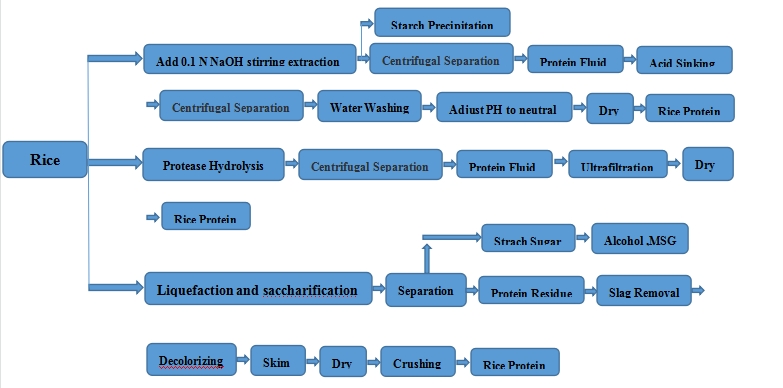Development And Application Of Rice Protein
2024-01-30 14:08:37
Production process of rice protein
The safety problem in the production and processing of animal protein has aroused widespread concern. Plant protein is superior to animal protein in edible safety
Source protein has become a hot topic in nutrition field. In recent years, because of its high nutritional value and low antigenicity, rice protein has received extensive attention at home and abroad, many well-known companies such as LMDBCNCADCO and /-NCN6; B+-KP and others have invested great efforts in the development and research of rice protein, and their products have been put into the market. There are three common production processes of rice protein, as shown in Figure 1.

Figure 1

Protein Nutritional Supplement
For infant sensitive diarrhea, rice protein with low antigenicity and high nutrition is widely used to develop high protein and low allergy infant formula rice flour. In addition, in pet food, rice protein is also a good protein source, compared with soybean, it contains less anti-nutritional factors, can be reduced small animal gastrointestinal flatulence is conducive to the digestion and absorption of protein. The concentrate of rice gluten is used for aquatic feed. The insolubility of gluten keeps the water clear and has high digestive performance, which can reduce the excretion of aquatic animals and reduce water pollution.
Study on functional short peptide of rice protein
Rice protease hydrolysates contain a variety of small peptides with physiological activities, which have antihypertensive, anti-aging, anti-morphine and immunomodulatory activities.
Researchers at Japan’s Minolta Cosmetics Co.,Ltd extracted a new type of peptide from the protein rice gel contained in rice.This peptide can effectively inhibit skin wrinkles,sagging and other commen skin aging phenomena in middle-aged and elderly people.
Rice protein is a storage protein and also exists in distiller's lees, a byproduct of rice wine processing. Saito et al. (1994) isolated peptides that showed angiotensin transferase (ACE) inhibitory activity from enzymatic hydrolysates of wine grains. SHR mice fed with 100mg/mL ARG-TYr and Ile-Tyr-Pro-ARg-TYr for 30h still had antihypertensive effect. Qiao Fengyun et al. (2004) reported that riceptide has certain medicinal and health care value, which can inhibit ACE, reduce hypertension, regulate human physiology and prevent diseases.
Takahashi et al. (2002) obtained a bioactive peptide Oryzatensin by enzymolysis of rice soluble protein with trypsin, which has the activity of inducing ileum contraction, anti-morphine and immunomodulatory activity in guinea pigs. It is speculated that ileal contraction may be caused by activation of phospholipase to hydrolyze lysophosphatidic acid and release arachidonic acid. Its mechanism of action is similar to that of ileal contraction caused by human complement C3a, and its amino acid sequence 70 ~ 77 of carboxyl terminal of C3a peptide has the same characteristics, and it can directly act on C3a receptor. Oryzatensin is a multifunctional peptide with a primary structure of Gly-Tyr-pro-Met-Tyr-pro-LEu-ARG, which has both opioid antagonistic activity and immunomodulatory activity. When the concentration was 1μmol/L,Oryzatensin could be used as a clear indicator, and the swallowing index was 1.5 times of the control value. Oryzatensin could also stimulate the production of superoxide ions around leukocytes.
The flavor peptide containing sodium tiglutaminate (MSG) could be separated from rice egg white by enzymolysis. Some protein feeds (such as rapeseed meal and cottonseed meal) have poor palatability. Adding glutamate polypeptide into the feed can effectively mask the bitter taste, enhance the viscosity of feed and improve the palatability of feed. Its application in animal husbandry can significantly improve the feeding rate of animals, and the source is safe and reliable, without toxic effect. Competition between mineral elements can also be reduced if such peptides are chelated with mineral trace elements.
China is a big rice producer with abundant rice protein resources. The research, development and utilization of rice protein not only provide new plants protein resources are beneficial to the deep processing and utilization of rice, and improve the economic benefits. Moreover, the small molecular peptides generated by the enzymatic hydrolysis of rice protein also have many biological activities, which provide more supplements for animal husbandry, food industry and human nutrition and health care, and have broad application prospects.
If you would like to learn more, please contact sales@sxytorganic.com
_1737093401309.png)
